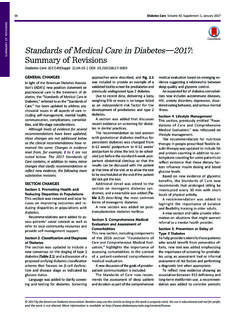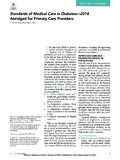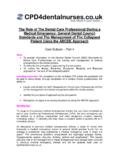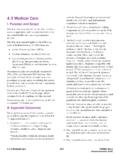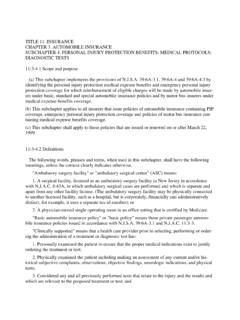Transcription of 1. Tips & Trends Articles 2. Procedures Articles 3. …
1 Billing Essentials 1. Tips & Trends Articles 2. Procedures Articles 3. Coding Articles 4. documentation Articles 5. compliance digest Legal Statement This web site is published by Professional Medical Billing and reproduction of any material without the expressed written permission of the publisher is prohibited. This web site is intended to provide accurate and authoritative information on the subject matter covered. This publication does not have any official authority and the information contained therein should not be acted upon without professional advice that should be related to specific situations. 1. Tips & Trends Articles REIMBURSEMENT ESSENTIALS TIPS & Trends FOR EMERGENCY MEDICINE PROFESSIONAL MEDICAL BILLING IS DEDICATED TO APPROPRIATE EMERGENCY MEDICINE REIMBURSEMENT HCFA Proposes New Reimbursement Model for Observation Codes in 2001 Fee Schedule In a development that could impact emergency medicine reimbursement beginning next year, the Health Care Financing Administration has proposed a new method for determining reimbursement for observation codes.
2 The proposed 2001 Medicare Physician Fee Schedule cuts relative values for certain observation codes approximately in half. This change came without input from specialty societies such as ACEP. Accordingly, ACEP plans to submit comments to express concern that HCFA is disregarding the CPT descriptors for the observation codes and has rewritten the codes to impose hourly thresholds on observation services instead of the previous one-day or next-day method. HCFA proposes to break down the codes into three categories: For observation of eight hours or less, Medicare will reimburse only the admission codes on that day. Between eight and 24 hours, for observation, or if a patient is admitted as an inpatient, HCFA would pay for both the admission and discharge services under CPT codes 99234 and 99236, with a reduction in physician work relative value units (RVUs).
3 For observation of 24 hours or more, Medicare will pay for both inpatient hospital admission services and hospital discharge services. ACEP officials are concerned that the new method adds significant potential for confusion. The good news coming out of the fee schedule, however, is that HCFA has restored the critical care relative value units to the 1998 levels for code 99281 and 99282 for a difference of 10%. The proposed 2001 physician fee schedule is available online at: Scroll down to Health Care Financing Administration and find the link to "Physician fee schedule (2001CY) payment policies." Important Changes to Critical Care Reimbursement Back to top New standards include prevention New CPT guidelines for critical care in the year 2000 remove the requirement that the patient must be unstable, and thus may allow broader utilization of the critical care codes.
4 Prior to January 1, 2000, it was a challenge to appropriately bill for critical care services required to prevent further deterioration in a patient likely to become unstable, since the critical care codes required the patient to actively be unstable. Here is an overview of the new standards for critical care reimbursement: Critical care reimbursement now applies to prevention Critical care services include but are not limited to the treatment or prevention of further deterioration of central nervous system failure, circulatory failure, shock-like conditions, renal, hepatic, metabolic, or respiratory failure, postoperative complications or overwhelming infection. Critical care is usually, but not always, given in a critical care area, such as the coronary care unit, intensive care unit, pediatric intensive care unit, respiratory care unit, or the emergency care facility.
5 Critical care for infants Critical care services provided to infants older than one month of age at the time of admission to an intensive care unit are reported with critical care codes 99291 and 99292. Critical care services provided to neonates (30 days of age or less at the time of admission to an intensive care unit) are reported with the neonatal critical care codes 99295, 99296, 99297 and 99298. The neonatal critical care codes are reported as long as the neonate qualifies for critical care services during the hospital stay. The reporting of neonatal critical care services is not based on time, the type of unit (eg, pediatric or neonatal critical care unit) or the type of provider delivering the care. Services included in critical care The following services are included in reporting critical care when performed during the critical period by the physician(s) providing critical care: the interpretation of cardiac output measurements (93561, 93562) chest X-rays (71010, 71020) blood gases, and information data stored in computers, including ECGs, blood pressures, hematologic data (99090) gastric intubation (91105) temporary transcutaneous pacing (92953) ventilator management (94656, 94657, 94660, 94662) vascular access Procedures (36000, 36410, 36415, 36600) Any services not listed above should be reported separately.
6 Tracking your critical care time The critical care codes 99291 and 99292 are used to report the total duration of time spent by a physician providing critical care services to a critically ill or critically injured patient, even if the time spent by the physician on that date is not continuous. For any given period of time spent providing critical care services, the physician must devote his or her full attention to the patient and, therefore, cannot provide services to any other patient during the same period of time. Time spent with the individual patient should be recorded in the patient s record. The time that can be reported as critical care is the time spent engaged in work directly related to the individual patient s care whether that time was spent at the immediate bedside or elsewhere on the floor or unit. For example.. Time spent in the emergency department reviewing test results or imaging studies, discussing the critically ill patient s care with other medical staff or documenting critical care services in the medical record would be reported as critical care, even though it does not occur at the bedside.
7 Also, when the patient is unable or clinically incompetent to participate in medical decisions, time spent in the emergency department with family members or surrogate decision-makers obtaining a medical history, reviewing the patient s condition or treatment may be reported as critical care, provided that the conversation bears directly on the medical decision-making. It is absolutely essential that you document your total critical care time in the patient s ED record. It is important that there is sufficient documentation in the medical record (such as nurse s notes) to support the total time you designate as critical care time. Medicare guidelines may differ The bad news is that HCFA lowered the RVUs for critical care by about 9%, thus decreasing Medicare s reimbursement for critical care services. Critical care code 99291 now has RVUs of for Medicare payment, vs.
8 RVUs of for E/M code 99285. As with most HCFA reimbursement changes, individual Medicare carriers may have some latitude regarding how they will interpret and implement the new guidelines. Therefore, refer to your local Medicare carrier s written instructions in its monthly Medicare Part B Bulletin which describes the carrier s critical care reimbursement policy changes. (For PMB clients in Indiana and South Carolina, Medicare carrier policies in these states follow the new CPT guidelines.) Don t bill critical care time Time spent in activities that occur outside of the unit or off the floor ( , telephone calls, whether taken at home, in the office, or elsewhere in the hospital) may not be reported as critical care since the physician is not immediately available to the patient. Time spent in activities that do not directly contribute to the treatment of the patient may not be reported as critical care, even if they are performed in the critical care unit ( , participation in administrative meetings or telephone calls to discuss other patients).
9 Code 99291 is used to report the first 30-74 minutes of critical care on a given date. It should be used only once per date even if the time spent by the physician is not continuous on that date. Critical care of less than 30 minutes total duration on a given date should be reported with the appropriate E/M code. Code 99292 is used to report each additional 30 minutes beyond the first 74 minutes. It also may be used to report the final 15-30 minutes of critical care on a given date. Critical care of less than 15 minutes beyond the first 74 minutes, or less than 15 minutes beyond the final 30 minutes, is not reported separately. HCFA Issues Ruling on Independent Contractor Reimbursement Back to top In April, HCFA Administrator Bruce Vladeck issued a ruling, which reaffirms that HCFA will not allow reassignment of Medicare benefits by independent contractor physicians.
10 An independent contractor physician is one who is not an employee of the hospital, physician staffing company or physician group and receives his/her wages reported on a 1099 form rather than a W-2 form. Although a patient may assign his/her benefits to a physician who provides the patient a service, Medicare restricts a physician's ability to reassign those benefits. Medicare allows an employed physician to reassign benefits to an employer or staffing company. However, Medicare does not allow an independent contractor physician to reassign benefits to an employer group or staffing company. A hospital may be entitled to bill and receive payment for a physician s services if the facility has a direct contractual arrangement with each physician according to the Medicare Carrier s Manual. When the new ruling takes effect, it appears that the Medicare reimbursement for an independent contractor physician can be handled in one of the following three ways: The physician can convert from independent contractor status to employee status.
